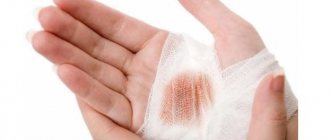Probably, summer is given to us in order to enjoy sunny days, get out into nature, admire its colors, travel and, of course, bask in the rays of the gentle sun. Some people use their summer vacation to visit southern countries, swim in the sea, lie on the beach and sunbathe. But both at home and at a party, one danger awaits us - an allergy to the sun. Why does it occur? How does it manifest? And what should you do if, after being in the sun, your skin suddenly becomes covered with red spots and itches mercilessly?
What is photodermatitis?
A sun allergy has little in common with a true allergy. The disease is caused by increased sensitivity of the skin to sunlight, but as such an allergen, that is, a foreign substance that directly causes the development of a true allergic reaction, does not exist. That is why the processes occurring in the skin during photodermatitis are called pseudo-allergic.
And yet, there are some common points between true allergies and photodermatitis. Substances that provoke the appearance of skin rashes after sunbathing still exist, however, they do not come from the outside, as in a true allergy, but are formed in the skin itself under the influence of ultraviolet radiation and become an irritant to the human immune system.
Diagnostics
Preliminary diagnosis includes interviewing the patient and external examination. To determine the type of allergen, the doctor prescribes application tests to the patient. To detect the endogenous causes of sun allergies, the doctor will prescribe the following studies to the patient:
- Zimnitsky samples;
- biochemical analysis of urine and blood;
- CT and ultrasound of the kidneys;
- Ultrasound of the abdominal cavity;
- hormone analysis;
- excretory urography.
When studying sun allergies, a distinction is made between diseases such as:
- lichen;
- sunburn;
- erysipelas;
- atopic, allergic, contact, radiation dermatitis;
- superficial form of SLE.
Cosmetics may cause sun allergies
Depending on the mechanism of occurrence, photodermatitis is divided into exogenous and endogenous.
With exogenous photodermatitis, substances located on the surface of the skin act as a trigger. Together with ultraviolet radiation, they cause the formation of allergens in the skin and the appearance of disease symptoms.
The following may act as a “provocateur”:
- sunscreens, especially if they contain para-aminobenzoic acid;
- cosmetics and perfumes;
- essential oils, for example, bergamot oil, St. John's wort, rose, sandalwood;
- dill and parsley juice;
- boric and salicylic acids, phenol, mercury preparations;
- polyunsaturated fatty acids in vegetable oils.
When packing your cosmetics bag for the sea, you should carefully select products and exclude those that can provoke allergies to the sun.
Another example of exogenous photodermatitis is meadow allergy. Its cause is furocoumarins in the pollen of meadow flowers and grasses that settle on human skin.
Prevention
Prevention helps prevent skin problems and promotes joyful sun exposure. Preventive measures include:
- Do not use perfumes and cosmetics containing essential oils, alcohol, fragrances, or acids;
- Start strengthening your immune system at the end of winter: drink vitamins, walk more in the fresh air;
- Eat berries and fruits containing antioxidants, vitamins A, E, B. For example, blueberries, apples, pomegranates, bananas;
- If possible, avoid spicy foods and exotic fruits;
- Staying on the beach when solar activity is low (morning and evening);
- Using sunscreen and after-sun lotion;
- Vary the time spent in the sun and shade;
- Wear a summer hat and glasses;
- Dry your skin after bathing and reapply the cream;
- Avoid dehydration, drink 1.5-2 liters of clean water per day;
- Conduct a preventive examination of the whole body to detect health problems in a timely manner.
Proper sun protection and self-care will help make the summer time carefree and joyful.
Sunburn How to treat a mosquito bite in a child at home Urticaria Cetirizine Polysorb MP Application of ASD fraction 2: benefits and harm to humans
When the causes of photodermatitis lie inside
Endogenous photodermatitis develops under the combined action of sunlight and substances accumulating in human skin.
Their causes may be:
- chronic liver diseases;
- metabolic diseases of hereditary and acquired nature;
- diseases of the adrenal glands and kidneys.
Young children are more likely to develop photodermatitis, when the internal mechanisms of skin protection are not yet formed, as well as people with fair skin.
Many medications cause increased sensitivity to sunlight: Tetracycline, Doxycycline, Amiodoron, Trazicor, Ibuprofen, Aspirin, oral contraceptives, cytostatics and even some antiallergic drugs.
The likelihood of developing a sun allergy increases sharply after cosmetic procedures, such as cleansing, peeling, mesotherapy, contouring, and tattooing.
List of photosensitizers
Photosensitizers are substances of various origins that cause increased sensitivity of the skin to solar radiation. Often they are the ones who provoke negative conditions in the dermis.
Therefore, if you belong to a risk group or are planning a vacation in the midst of summer days, then you should exclude the list of the following products and medications from use:
- alcoholic drinks, especially red wine;
- tomatoes, carrots, sour apples, citrus fruits, figs, pomegranate, parsley, celery;
- freshly squeezed juices from these products;
- cosmetics containing oils of musk, bergamot, lime;
- aspirin;
- cardio medications (Cardiomagnyl, Magnicor, etc.);
- retinol cream;
- vitamins B6 and B2;
- diuretics (Furasemide, Pamid, Indap);
- antifungal agents (Griseofulvin, Lamisil, Tsidokan, etc.);
- fluoroquinolones (Ofloxocin, Ciprofloxocin, etc.);
- cream or medications containing St. John's wort;
- antibiotics of the tetracycline group (Doxal, Doxycillin, Unidox, Tetracycline, Rondomycin, etc.);
- corticosteroid hormonal drugs (Prednisolone, Hydrocortisone, Sinaflan, Dermovate, etc.);
- drugs that slow down cell division (Flutamide, Methotrexate, Azotriopine, etc.);
- means for lowering blood sugar (Diabeton, Siofor, Novonorm, etc.);
- antidepressants, antipsychotics (Bifol, Azafen, Aminosyl, Truxal, etc.);
- oral contraceptives with a high content of estrogen (Tri-regol, Ovidon, etc.).
In order to protect yourself and your loved ones, carefully study the instructions for medications and follow the recommendations of your doctor.
How not to confuse sun allergy with sunburn?
Most often, manifestations of photodermatitis occur with the first rays of spring and worsen after sunbathing throughout the summer.
Typically, from the moment of exposure to sunlight until the appearance of allergy symptoms, it takes from several hours to two days. The rash is preceded by itching of the skin; it can occur already during sunbathing. Then, after about a day, a rash appears on the irradiated areas of the skin. Most often, it has the appearance of urticaria, that is, small tubercles merging into blisters; less often, blisters form, after opening which, erosions remain on the skin, healing after 2-5 days with the formation of crusts, and leaving behind persistent pigmentation. Considering that the whole picture of photodermatitis unfolds against the background of general redness of the skin, it is quite easy to confuse an allergy to the sun with ordinary sunburn. Treatment for these conditions varies, so if in doubt, it is better to immediately consult a dermatologist.
There is also a chronic form of sun allergy, which in its course resembles eczema, accompanied by severe itching. This type of sun intolerance is more common in middle-aged and older men.
Selfie for the doctor
— How are solar urticaria and photodermatoses treated?
— If symptoms occur, you should consult a specialist as soon as possible for differential diagnosis. To confirm solar urticaria and other photodermatoses, phototesting is mandatory. Phototesting is used to determine the range of solar radiation that causes the disease. For photoallergic contact dermatitis, photopatch tests are used with drugs that are suspected of causing this reaction.
Many patients come to an allergist-immunologist or dermatologist when they return from vacation, several weeks after the occurrence of an allergic reaction. In such a situation, it is quite difficult to interpret the symptoms. Therefore, it is advisable to photograph changes in the skin if they occur while relaxing on the beach and contact a specialist in a timely manner.
Treatment also has fundamental differences. For urticaria, use non-sedating antihistamines; for chronic cases, more specialized approaches are possible. Phototherapy is successfully carried out in our clinic; it is an effective method and involves exposure to increasing doses of ultraviolet radiation to develop tolerance. With solar urticaria, severe variants are also possible, including systemic reactions of the body, which may require emergency care. In the case of photoallergic contact dermatitis, it is necessary to exclude the culprit photoallergen, and topical glucocorticosteroids and other drugs are used.
Doctor, is this forever?
Treatment of sun allergies involves eliminating exposure to ultraviolet radiation. In the case of solar urticaria, antihistamines help, and there are special medications that thicken the skin and reduce its sensitivity to sunlight. Treatment in this case consists of gradually accustoming the skin to the sun while taking medication.
To relieve exacerbation of photodermatitis, local treatment is prescribed in the form of ointments, sometimes hormonal, and internal treatment: vitamins B, E, C, nicotinic acid, non-steroidal anti-inflammatory and antihistamines. Usually the course of treatment continues for several days or weeks. During this time, it is recommended to spend less time in the sun, wear a wide-brimmed hat, clothes with sleeves and sunglasses.
If sun allergy is left untreated, repeated episodes will lead to the development of photodermatosis. When you have managed to stop the allergy attack by carefully taking care of protecting your skin, eliminating provoking factors and strictly following the sunbathing regime, you have the opportunity to bask in the gentle rays. Sun allergies can be controlled and prevented, and children may even outgrow this disease.
medkrug.ru
Folk remedies
The first symptoms of allergies can be relieved with folk remedies:
- Application of cabbage. It is necessary to lightly beat a cabbage leaf so that it begins to release juice and apply it to the affected areas of the skin.
- Compresses. Apply compresses made from sliced or grated potatoes and cucumbers. Keep it for about half an hour.
- Celandine and wormwood. Pour the young wormwood herb with alcohol and leave for three days. Use the resulting tincture to wipe the rash areas. Take baths with celandine infusion.
Literature:
- Improving the treatment of patients with polymorphic photodermatosis, taking into account clinical, immunogenetic and morphological indicators: abstract of the dissertation for the scientific degree of candidate of medical sciences: specialty 14.00.11 / Inoyatov Avaz Shavkatovich; Ministry of Health of the Republic of Uzbekistan, Tashk. honey. acad. — Tashkent: 2008
- “Photodermatoses: clinical picture, treatment, prevention” Elkin V.D., Schastlivtseva L.V., Bolotova A.A., Plotnikova E.V., Mitryukovsky L.S.
- N. F. Yarovaya, Candidate of Medical Sciences, Associate Professor of the State Educational Institution of Further Professional Education RMAPO, Moscow Magazine “Attending Physician” dated 05-06/2009
- Brawan J., Andersen W., Lee J., Labadie R., Solares G. Photoaging versus intrinsic aging: a morphologic assessment of facial skin // J Cutan Pathol. 1995; 22 (2): 154–159.
- Finkel P. Sun protection factor and UVA protection labeling in Europe // Euro Cosmetics. 1999; 4:34–38.
Clinical researches
The conducted clinical study proves the high efficiency, safety and tolerability of products for daily skin care of children and adults with mild and moderate forms of atopic dermatitis and during remission, accompanied by a decrease in the quality of life of patients. As a result of therapy, a decrease in the activity of the inflammatory process, a decrease in dryness, itching and flaking was noted.
Based on the results of joint research, the following information is placed on product packaging: “Recommended by the St. Petersburg branch of the Union of Pediatricians of Russia.”
Sources:
- Ratner Desiri, Avram M.R., Avram M.M., Procedures in Dermatology. Clinical cosmetology, GEOTAR-Media, 2021.
- Sukolin Gennady Ivanovich, Clinical dermatology. A short guide to the diagnosis and treatment of dermatoses, Notabene, 2017.
- Sukolin Gennady Ivanovich, Illustrated clinical dermatology. Brief alphabetical reference book, Lux Print publishing house, 2010.
Photos of dermatitis
Classification of skin types
Before we start talking about the different types of photodermatitis, it is necessary to understand what types of skin there are. The effect of ultraviolet rays on the skin directly depends on the type of skin. The following types of phototype are distinguished:
Type I - redheads. Burns always occur.
Type II - lightly tanned blondes. Burns always occur.
Type III - Europeans with a medium tan. Sometimes burns occur.
Type IV – Asians and Indians who tan easily. Burns rarely occur.
Type V - people with moderate pigmentation and always tanned skin - mulattoes and mestizos.
Type VI - people with deep pigmentation - Negroids. There are no burns.
Read also
Allergic dermatitis
What is allergic contact dermatitis? Anyone has ever experienced skin symptoms after using various skin care products, shower gel or shampoo.
In such… Read more
Allergic conjunctivitis
What is allergic conjunctivitis With prolonged exposure of the human body to allergens, such as pollen, yeast spores, eye symptoms associated with inflammation may appear.…
More details
Drug allergy
What is a drug allergy? A drug allergy is an abnormal reaction of the immune system to medications. Any medicine—over-the-counter, prescription, or herbal—can cause this condition. However,…
More details
Pollen allergy
What is a pollen allergy? Pollen is a fine mist produced by trees, flowers, grasses and weeds for the purpose of reproduction. Many people have an unfavorable immune response...
More details
Cold urticaria
Cold urticaria is a condition characterized by the onset of swelling and redness 5-20 minutes after exposure to cold or subsequent warming, most often localized on the face and hands.…
More details
Interaction with the Earth
The location of the Earth and the Sun relative to each other is not the same. Our planet constantly moves around the star in its orbit. It makes a full revolution in one year or approximately 365 days. During this time, it covers a distance of 940 million kilometers. No movement is felt on the planet itself, although it travels approximately 108 kilometers every hour. The consequences of such a journey manifest themselves on Earth in the form of changing seasons.
Read also: What tests can you ask on Instagram?
However, the seasons are determined not only by the movement around the Sun, but also by the tilt of the earth's axis. It is tilted 23.4 degrees relative to its orbit, so different parts of the planet are not equally illuminated and warmed by the star. When the Northern Hemisphere is turned towards the Sun, it is summer, and in the Southern Hemisphere it is winter at the same time. Six months later, everything changes exactly the opposite.
We often say that the Sun appears during the day. But this is just an expression, because it creates our day. Its rays break through the atmosphere, illuminating the planet from morning to evening. Their brightness is so strong that we simply cannot see other stars during the day. At night, the Sun does not stop shining, the Earth simply turns to it first on one side or the other, because it rotates not only in orbit, but also around its own axis. It makes a full revolution in 24 hours. On the side facing the luminary there is day, on the opposite side there is night, they change every 12 hours.











